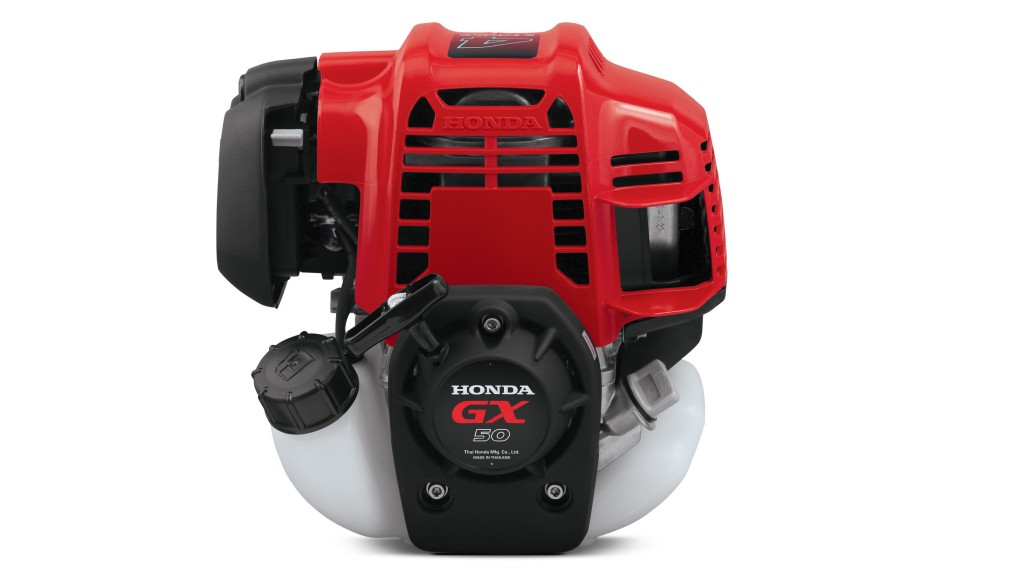Honda GX50 mini-four stroke adds power and performance in lightweight package

At the 2019 ARA Show, the American Rental Association's annual convention and trade venue for the equipment and event rental industry, Honda Engines introduced the all-new, high-output Honda GX50, expanding the company's Mini-Four Stroke lineup with a more powerful model. Joining the Honda GX25 and Honda GX35 Mini-Four Stroke models, the new GX50 incorporates a higher displacement, making it an ideal power match for demanding rental, industrial, construction and professional landscape applications. Available now, the versatile Honda GX50 brings its light weight, compact design, easy starting and excellent fuel efficiency to power products ranging from brush cutters to rammers and vibrators to concrete screeds, post drivers and winches.
More than 20 years ago, Honda introduced its GX22 and GX31 Mini-Four Stroke engines, models that would, for the first time, be used to power handheld power equipment. In a market previously dominated by two-stroke engines, Honda developed the industry's first 360-degree inclinable four-stroke models, and the company's successful product development continued with the 2002 launch of the Honda GX25 and GX35 Mini-Four Strokes. These engines, with a higher output and more lightweight than the GX22 and GX31, incorporated an advanced design including a cross-flow combustion chamber, providing a wide, smooth range of torque unique to four-stroke technology. State-of-the-art design and manufacturing techniques have reduced the number of moving parts, and many of these techniques have resulted in reduced engine weight and smoother operation for the end user.
So why a Honda GX50? As the world's largest manufacturer of engines for a diverse array of automotive, motorcycle, marine, and power equipment products, Honda continually listens to marketplace need. In the mini-four stroke space, customers requiring higher output engines for different types of handheld equipment requested a two-horsepower class, four-stroke engine with superior fuel efficiency and higher work efficiency. In 2019, Honda responds with the GX50, a four-stroke model with a power-to-weight ratio matched to leading two-stroke models. With valvetrain parts installed inside the oil chamber, low noise and low vibration, the all-new Honda GX50 can power even more applications in the handheld market.
"Today's all-new Honda GX50 is the next evolution in the mini-four stroke category, the first four-stroke engine in the two-horsepower class that is 360-degrees inclinable during operation and storage," said Will Walton, Vice President, Honda Power Equipment. "Excellent fuel efficiency, low emissions, high output and easy starting performance, combined with low noise and vibration, as well as a compact, lightweight design, place the Honda GX50 engine squarely into the demanding rental, industrial, construction and professional landscape space."
The Honda GX50: At Work for the Customer
The all-new Honda GX50 engine integrates a number of features that add up to high performance combined with an improved user experience. With a maximum output of 1.47kW (1.97 horsepower) and weight of 4.72 kg (10.4 lbs.), the power-to-weight ratio of the Honda GX50 is equal to a comparable two-stroke engine; however, the GX50 produces lower emissions while being more fuel efficient. With low emissions and excellent fuel efficiency, the Honda GX50 complies with the most stringent environmental regulations, including EPA Phase III/CARB tier III/EU Stage 5.
Turning to usability, the Honda GX50 engine is easy to start with an automatic decompressor reducing the pulling force on the recoil rope. The all-new mini-four stroke model also is easy to operate because it is lighter in weight, quieter and incorporates reduced vibration over a comparable two-stroke engine. In turn, reducing weight, noise and vibration reduces stress on the operator, makes the equipment more comfortable to use, and increases worker efficiency—all while producing top-class performance.
Rounding out the engine's footprint and benefits that customers will appreciate, the Honda GX50 features a condensed, compact design with long, vertical lines, and its attachments and connectors share an integrated, slanted shape. Equally important, the all-new GX50 is 360-degrees inclinable (see discussion below), allowing it to be operated and stored in any position. Further, the engine integrates an innovative Bridge Guard Design, a wide, scratch-resistant area with protruding edges that provides stability and serves to protect the engine cowling in upside down positions during maintenance intervals.
A Deeper Look Inside the Honda GX50
A combination of technical factors makes the all-new Honda GX50 360-degrees inclinable during operation and in storage. To illustrate, the up-and-down motion of the engine's piston creates a change in negative pressure inside the crankcase and acts like a pump. When the piston lifts, it creates suction, and when the piston drops, it discharges oil. Further, a reed valve opens and closes from the negative pressure inside the crankcase. In the breather chamber, the blow-by gas and oil mist are separated and sent back to the oil chamber. When the crankcase has negative pressure, an oil slinger produces a mist of oil, and the oil flows into the shaft from the oil changer.
Honda produced the compact and lightweight design of the Honda GX50, in part, by integrating the valvetrain chamber into the oil chamber. This in-oil timing belt, the smallest class in-oil timing belt, also is made of a highly durable material usually found in high rotational speed engines.
For ease in starting, Honda incorporated an automatic decompression mechanism into the design of the all-new GX50, serving to reduce the recoil pull load and thereby reducing the start-up load. The mechanism consists of a decompression weight and spring that depresses the exhaust valve side rocker arm. The weight attached to the cam pulley moves by centrifugal force, and when the recoil starter rope is pulled, the exhaust valve is opened slightly during the compression stroke by the decompressor and reduces engine compression. While the engine is running, if the engine RPM is above the control value, centrifugal force causes the weight to move and keep the exhaust valve closed during the compression stroke, and the exhaust valve operates normally. Overall, reducing the pressure inside the cylinder lessens the amount of effort required to pull the recoil starter. Finally, an inner protector between the muffler and the outer cover helps to reduce noise and produce quiet engine operation.




